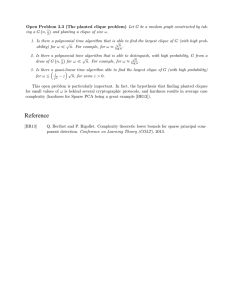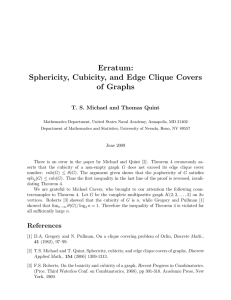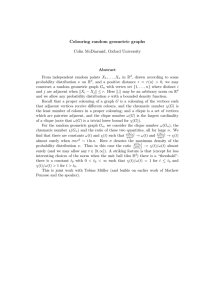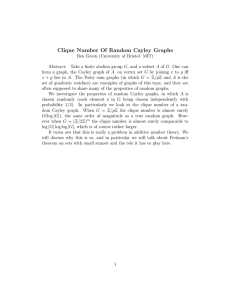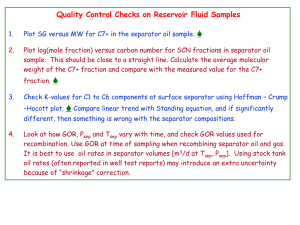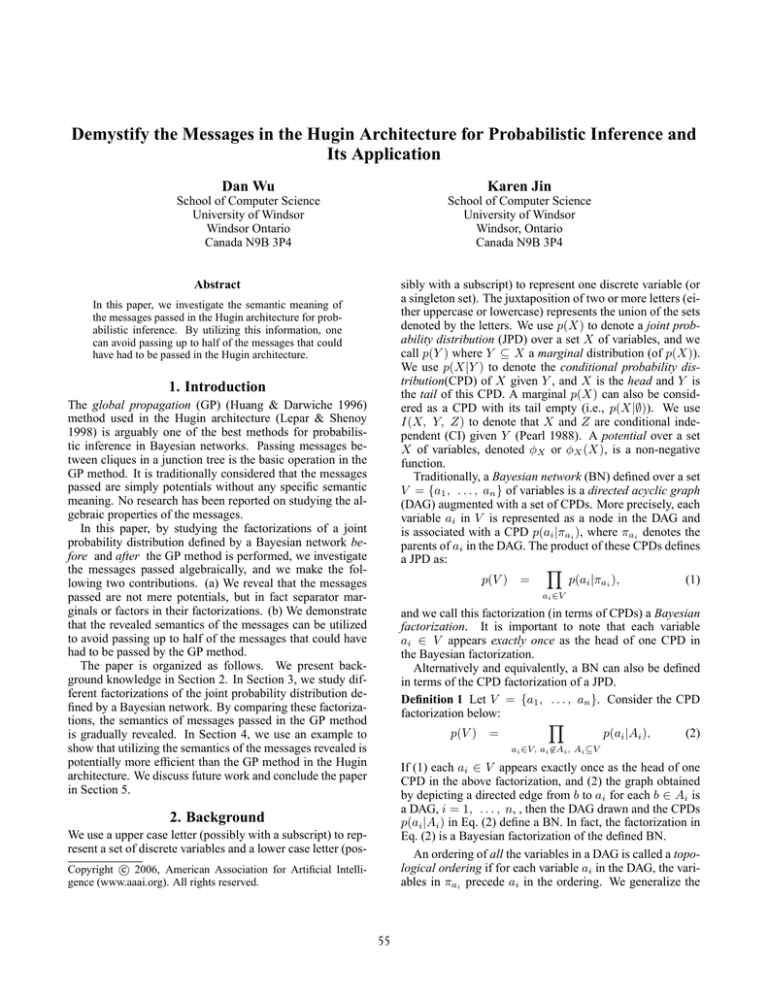
Demystify the Messages in the Hugin Architecture for Probabilistic Inference and
Its Application
Dan Wu
Karen Jin
School of Computer Science
University of Windsor
Windsor Ontario
Canada N9B 3P4
School of Computer Science
University of Windsor
Windsor, Ontario
Canada N9B 3P4
Abstract
sibly with a subscript) to represent one discrete variable (or
a singleton set). The juxtaposition of two or more letters (either uppercase or lowercase) represents the union of the sets
denoted by the letters. We use p(X) to denote a joint probability distribution (JPD) over a set X of variables, and we
call p(Y ) where Y ⊆ X a marginal distribution (of p(X)).
We use p(X|Y ) to denote the conditional probability distribution(CPD) of X given Y , and X is the head and Y is
the tail of this CPD. A marginal p(X) can also be considered as a CPD with its tail empty (i.e., p(X|∅)). We use
I(X, Y, Z) to denote that X and Z are conditional independent (CI) given Y (Pearl 1988). A potential over a set
X of variables, denoted φX or φX (X), is a non-negative
function.
Traditionally, a Bayesian network (BN) defined over a set
V = {a1 , . . . , an } of variables is a directed acyclic graph
(DAG) augmented with a set of CPDs. More precisely, each
variable ai in V is represented as a node in the DAG and
is associated with a CPD p(ai |πai ), where πai denotes the
parents of ai in the DAG. The product of these CPDs defines
a JPD as:
Y
p(V ) =
p(ai |πai ),
(1)
In this paper, we investigate the semantic meaning of
the messages passed in the Hugin architecture for probabilistic inference. By utilizing this information, one
can avoid passing up to half of the messages that could
have had to be passed in the Hugin architecture.
1. Introduction
The global propagation (GP) (Huang & Darwiche 1996)
method used in the Hugin architecture (Lepar & Shenoy
1998) is arguably one of the best methods for probabilistic inference in Bayesian networks. Passing messages between cliques in a junction tree is the basic operation in the
GP method. It is traditionally considered that the messages
passed are simply potentials without any specific semantic
meaning. No research has been reported on studying the algebraic properties of the messages.
In this paper, by studying the factorizations of a joint
probability distribution defined by a Bayesian network before and after the GP method is performed, we investigate
the messages passed algebraically, and we make the following two contributions. (a) We reveal that the messages
passed are not mere potentials, but in fact separator marginals or factors in their factorizations. (b) We demonstrate
that the revealed semantics of the messages can be utilized
to avoid passing up to half of the messages that could have
had to be passed by the GP method.
The paper is organized as follows. We present background knowledge in Section 2. In Section 3, we study different factorizations of the joint probability distribution defined by a Bayesian network. By comparing these factorizations, the semantics of messages passed in the GP method
is gradually revealed. In Section 4, we use an example to
show that utilizing the semantics of the messages revealed is
potentially more efficient than the GP method in the Hugin
architecture. We discuss future work and conclude the paper
in Section 5.
ai ∈V
and we call this factorization (in terms of CPDs) a Bayesian
factorization. It is important to note that each variable
ai ∈ V appears exactly once as the head of one CPD in
the Bayesian factorization.
Alternatively and equivalently, a BN can also be defined
in terms of the CPD factorization of a JPD.
Definition 1 Let V = {a1 , . . . , an }. Consider the CPD
factorization below:
Y
p(V ) =
p(ai |Ai ),
(2)
ai ∈V, ai 6∈Ai , Ai ⊆V
If (1) each ai ∈ V appears exactly once as the head of one
CPD in the above factorization, and (2) the graph obtained
by depicting a directed edge from b to ai for each b ∈ Ai is
a DAG, i = 1, . . . , n, , then the DAG drawn and the CPDs
p(ai |Ai ) in Eq. (2) define a BN. In fact, the factorization in
Eq. (2) is a Bayesian factorization of the defined BN.
An ordering of all the variables in a DAG is called a topological ordering if for each variable ai in the DAG, the variables in πai precede ai in the ordering. We generalize the
2. Background
We use a upper case letter (possibly with a subscript) to represent a set of discrete variables and a lower case letter (posc 2006, American Association for Artificial IntelliCopyright gence (www.aaai.org). All rights reserved.
55
notion to a subset of variables in a DAG. Let V represent the
set of all variables in a DAG, a subset X ⊆ V of variables is
said to be in a topological ordering with respect to the DAG,
if for each variable ai ∈ X, the variables in the intersection
of ai ’s ancestors and X precede ai in the ordering. We say
that a Bayesian factorization follows a topological ordering
if for each CPD p(ai |πai ), variables in πai precede variable
ai in the ordering. Note that the DAG of a BN may have
many different topological orderings, and its Bayesian factorization follows all these orderings. We can say that all
these topological orderings lead to the same Bayesian factorization (Pearl 1988).
a
p(a)
p(c|a)
c
b
p(d |b)
d
f
h p(h |f)
ac
c
f
de f
de
d,f
f
efg
(i)
bde
cdf
ef
fh
de f
ac
c
cdf
ef
efg
fh
(ii)
bde
de
d,f
f
de f
ef
fh
efg
(iii)
Figure 2: (i) The Junction tree constructed from the DAG in
Fig. 1. (ii) Passing messages in the Collect-Evidence stage,
and (iii) passing message in the Distribute-Evidence stage,
when c4 = def is chosen as the root.
e
or more cliques, then we arbitrarily assign p(ai |πai ) to one
of the cliques. If no CPD is assigned to a clique cj , then
φcj = 1. In our example, the following clique potentials
will be obtained before the GP is applied:
p(f | cd)
p(g |h)
d,f
ac
c
de
cdf
p(b)
p(e | b)
bde
g
φc1 (ac) =
p(a) · p(c|a),
φc2 (bde) = p(b) · p(d|e) · p(e|b),
φc3 (cdf ) =
p(f |cd),
Figure 1: The DAG of the Asia travel BN.
Example 1 Consider the Asia travel BN defined over V =
{a, . . . , h} from (Lauritzen & Spiegelhalter 1988). Its
DAG and the CPDs associated with each node are depicted
in Fig. 1. The JPD p(V ) is obtained as: p(V ) = p(a) · p(b) ·
p(c|a) · p(d|b) · p(e|b) · p(f |cd) · p(g|ef ) · p(h|f ). The ordering < a, b, c, d, e, f, g, h > is a topological ordering.
The ordering < b, d, h > is a topological ordering for the
subset {b, d, h} with respect to the DAG.
φc4 (def ) = 1
φc5 (f h) = p(h|f )
φc6 (ef g) = p(g|f e)
(3)
In the meantime, a separator potential is also formed for each
separator with initial value 1, that is, φsi = 1, i = 1, . . . , 5.
It is known that the following equation holds before the GP
method is performed on the junction tree:
p(V )
= φc1 · φc2 · φc3 · φc4 · φc5 · φc6 .
(4)
Note the separator potentials φsi (·) are identity potential
(φsi = 1) before the GP method is applied.
The basic operation in the GP method is a local computation called message pass. Consider two adjacent cliques ci
and cj with the separator sij , that ci passes a message to cj
(or cj absorbs the message from ci ) means a two-step computation: P
(1) updating the separator clique φsij by setting
φsij = ( ci −sij φci )/φsij ; (2) updating the clique potential φcj by setting φcj = φcj · φsij . The potential φsij is the
so-called “message” passed from ci to cj . Obviously, φsij
in general is just a non-negative function.
The GP method is a coordinated sequence of message
passes. Consider a junction tree with n cliques. It begins by picking any clique in the junction tree as the root,
and then performs a sequence of message passes divided
into two stages, namely, the Collect-Evidence stage, and
the Distribute-Evidence stage. During the Collect-Evidence
pass, each clique in the junction tree passes a message to its
neighbors towards the root, beginning with the clique farthest from the root. During the Distribute-Evidence pass,
each clique in the junction tree passes a message to its neighbor away from the root’s direction, beginning with the root
itself. The Collect-Evidence stage causes n − 1 messages to
be passed. Similarly, the Distribute-Evidence stage causes
another n − 1 messages to be passed. Altogether, there are
exact 2(n − 1) messages to be passed (Huang & Darwiche
1996; Jensen 1996). The sequence of message passes is
A BN is normally transformed into a junction tree for probabilistic inference. Among various algorithms developed, the
GP method (Lauritzen & Spiegelhalter 1988; Shafer 1991;
Jensen, Lauritzen, & Olesen 1990; Lepar & Shenoy 1998)
is well received and implemented, for instance, in the
renowned Hugin architecture. The GP method realizes the
inference task not directly on the DAG of a BN, but on a
secondary structure called junction tree. The junction tree is
constructed from the DAG through moralization and triangulation. The GP method in essence is a coordinated series
of local manipulations called message passes on the junction
tree. Readers are referred to (Huang & Darwiche 1996) for
detailed exposition. The following highlights pertinent facts
of the GP method that are relevant to the discussions in this
paper using an example.
Consider the Asia travel BN in Example 1. The DAG in
Fig. 1 is moralized and triangulated so that a junction tree
such as the one in Fig. 2 (i) is constructed. This junction tree
consists of 6 cliques depicted as round rectangles, denoted
c1 = ac, c2 = bde, c3 = cdf , c4 = def , c5 = f h, c6 = ef g,
and 5 separators depicted as smaller rectangles attached to
the edge connecting two incidental cliques, denoted s1 =
c, s2 = de, s3 = df , s4 = f , s5 = ef .
Every CPD p(ai |πai ) in Fig. 1 is assigned to a clique cj
if {ai } ∪ πai ⊆ cj to form the clique potential φcj before
the GP method is applied. If {ai } ∪ πai is a subset of two
56
potential
φ c1
φc2
φc3
φ c4
φc5
φc6
shown in Fig. 2 (ii) and (iii) when the clique c4 = def was
chosen as the root.
After passing all 2(n−1) messages, the potentials φci and
φsj will have been turned into marginals p(ci ) and p(sj ) respectively, and the following equation holds (Huang & Darwiche 1996).
p(V ) =
p(c1 ) · p(c2 ) · p(c3 ) · p(c4 ) · p(c5 ) · p(c6 )
.
p(s1 ) · p(s2 ) · p(s3 ) · p(s4 ) · p(s5 )
Table 1: Allocating separator marginals, the underlined
terms are either the separator marginals or from the factorization of a separator marginal.
3. Demystify the Messages
the clique potential φc6 (ef g) = p(g|ef ), we can multiply it with the separator marginal p(ef ) which results in
φc6 (ef g) = p(g|ef ) · p(ef ) = p(ef g). So far, we have
successfully obtained marginals for cliques c1 , c2 , c5 , and
c6 and we have consumed the separator marginals p(f ) and
p(ef ) during this process. We still need to make the remaining clique potentials φc3 (cdf ) = p(f |cd) and φc4 (def ) = 1
marginals by consuming the remaining separator marginals,
i.e., p(c), p(de) and p(df ). In order to make φc3 (cdf ) =
p(f |cd) marginal, we need to multiply it with p(cd), however, we only have the separator marginals p(c), p(de) and
p(df ) at our disposal. It is easy to verify that we cannot
mingle p(de) with φc3 (cdf ) = p(f |cd) to obtain marginal
p(cdf ). Therefore, p(de) has to be allocated to the clique
potential φc4 (def ) such that φc4 (def ) = 1 · p(de). We now
only have p(df ) at our disposal for making φc4 (def ) a marginal. Note that p(df ) = p(d) · p(f |d), and this factorization of the separator marginal helps make φc4 (def ) = p(de)
a marginal by multiplying p(f |d) with φc4 (def ) to obtain
φc4 (def ) = p(de) · p(f |d). It is perhaps worth pointing
out that the CI I(f, d, e) holds in the original DAG in
Fig. 1. Therefore, φc4 (def ) = p(def ). We are now left
with the separator marginal p(c) and p(d) (from the factorization of the separator marginal p(df )) and the clique potential φc3 (cdf ), and p(c) and p(d) have to be multiplied
with φc3 (cdf ) to yield φc3 (cdf ) = p(f |cd) · p(c) · p(d).
Again, since CI I(d, ∅, c) holds in the original DAG in
Fig. 1, φc3 (cdf ) = p(cdf ). We have thus so far successfully
and algebraically used all separate marginals to transform
each clique potential φci into a marginal p(ci ). Table 1 summarizes the allocation scheme for the multiplied separator
marginals.
3.1 A Motivating Example
Comparing Eq. (4) with Eq. (5) leads us to the demystification of the messages. In the following, we will consider how
one can transform Eq. (4) to Eq. (5) algebraically.
Recall that the clique potentials in Eq. (4) are in fact composed of the original CPDs from the BN shown in Fig. 1. If
we substitute the actual contents for the clique potentials in
Eq. (4), we obtain the following:
φc2
z
}|
{ z
}|
{
p(V ) = [p(a) · p(c|a)] · [p(b) · p(d|e) · p(e|b)] ·
φc3
φc4
φc5
φc6
z }| { z}|{ z }| { z }| {
[p(f |cd)] · [1] · [p(h|f )] · [p(g|f e)]
(6)
Comparing Eq. (6) with Eq. (5), one may immediately
notice that Eq. (6) does not have any denominators as Eq. (5)
does. By multiplying and dividing Π5j=1 p(sj ) at the same
time to Eq. (6), one will obtain1 :
[c · de · df · f · ef ] ·
p(V ) =
c1
c2
c3
c4
c5
c6
z }| { z }| { z }| { z}|{ z }| { z }| {
[a, c|a] · [b, d|e, e|b] · [f |cd] · [1] · [h|f ] · [g|f e]
c·de·df ·f ·ef
.(7)
Comparing Eq. (7) with Eq. (5), one may find that they
both have exactly the same denominators except the numerators. In Eq. (7), we now have some extra dangling marginals, namely p(sj ), that are acquired when we multiply
Π5j=1 p(sj ) to Eq. (6), and we hope that by mingling these
extra marginals appropriately with the existing CPDs in the
numerators in Eq. (7), we can reach Eq. (5).
With the ultimate goal of transforming the product in each
square bracket (namely, the clique potential) in Eq. (7) into
a clique marginal on its respective clique in mind, we examine how each separator marginal multiplied can be allocated to appropriate clique potentials in Eq. (3). It is obvious that: φc1 (ac) = p(a) · p(c|a) = p(ac) and φc2 (bde) =
p(b) · p(d|b) · p(e|b) = p(bde). In other words, no separator marginal should be mingled with these two potentials to
make them marginals. For the clique potential φc5 (f h) =
p(h|f ), we can multiply it with the separator marginal p(f )
which results in φc5 (f h) = p(h|f ) · p(f ) = p(f h). For
1
result
p(a) · p(c|a) = p(ac)
p(b) · p(d|b) · p(e|b) = p(bde)
p(f |cd) · p(c) · p(d) = p(cdf )
p(de) · p(f |d) = p(def )
p(h|f ) · p(f ) = p(f h)
p(g|ef ) · p(ef ) = p(ef g)
(5)
Although the mechanism of the GP method is well understood, what indeed the semantic meaning of the messages
φsi is remains mysterious.
φc1
receives
nothing
nothing
p(c), p(d)
p(de), p(f |d)
p(f )
p(ef )
3.2 Observations
One may perhaps consider the success of the example in Sect
3.1 as a sheer luck. In the following, we will show that this
is not a coincidence.
According to the GP method in the Hugin architecture,
every clique ci in the junction tree was initially associated
with a clique potential φci . During the course of propagation, the clique receives messages from all its neighbors,
and the clique potential φci multiplies with all these received
messages. The result of the multiplication is p(ci ). In other
words, the GP method transforms the clique potential φci
into a clique marginal p(ci ). This algorithmic phenomena
Due to limited space, we write a for p(a), b|d for p(b|d), etc.
57
neighboring clique, for example, the separator marginal
p(c), p(de), p(f ), and p(ef ) in the figure. If the variables
in the separator are pointing to different neighboring cliques,
that means the separator marginal has to be factorized before
the factors in the factorization can be allocated according to
the arrow. For example, the separator marginal p(df ) has to
be factorized so that the factor p(d) is allocated to φc3 (cdf )
and p(f |d) is allocated to φc4 (def ). (The factorization of a
separator marginal will be further discussed shortly.)
of the GP method can be explained algebraically. Consider Eq. (7), in which the numerators are the original clique
potentials together with the multiplied separator marginals.
Every clique potential has to mingle with some appropriate
separator marginal(s) or its factorization if necessary to be
transformed into a marginal. The messages received by all
the cliques in the GP method as a whole, which algorithmically transform each clique potential into a clique marginal,
have the same effect as the separator marginals we multiplied in Eq. (7), which algebraically transform each clique
potential into a clique marginal. This analysis leads to the
following proposition.
p(a), p(c|a)
p(b), p(d|b), p(e|b)
a c
Proposition 1 The product of the messages received by
every clique in the GP method equals to the product of all
separator marginals.
p(c)
b d e
c
cdf
Recall the motivating example in Sect 3.1, in which we
successfully mingle the separator marginals with the clique
potential. This perfect arrangement of separator marginals
is not a coincidence, in fact, it can always be achieved as we
explain below.
Assigning either a separator marginal or its factorization
to a clique potential, as shown in Sect 3.1, must satisfy one
necessary condition, namely, condition (1) of Definition 1,
in order for the product of the clique potential with the allocated separator marginal or its factorization to be a marginal.
That’s to say, for each φci , we need a CPD with aj as head
for each aj ∈ ci . If a variable, say aj , appears m times in
m cliques in the junction tree, then each of these m cliques
will need a CPD with aj as head. However, the original BN
only provides one CPD with aj as head, and we are short of
m − 1 CPDs (with aj as head). Fortunately, m cliques containing aj implies the junction tree must have exactly m − 1
separators containing the variable aj (Huang & Darwiche
1996), therefore the m − 1 needed CPDs with aj as head
will be supplied by the m − 1 separator marginals (or their
factorizations). This analysis leads to a simple procedure to
allocate separator marginals.
Procedure: Allocate Separator Marginals (ASM)
p(f)
d e p(de)
p(d)
p(f|cd)
f
d,f
p(f|d)
de f
e f p(ef)
fh
efg
p(h|f)
p(g|ef)
Figure 3: Allocating separate marginals by ASM.
Proposition 2 For each separator in a junction tree, one
can always assign either the separator marginal or some
factors in its factorization to an appropriate clique ci as
dictated by the procedure ASM, such that for each variable
aj ∈ ci , there is a CPD assigned/allocated to the clique φci
in which aj is the head.
Although an appropriate allocation of the separator marginals can always be guaranteed to satisfy condition (1) of
Definition 1, one still needs to show that such an allocation
will not produce a directed cycle when verifying condition
(2) of Definition 1. It is important to note that a directed
cycle can be created in a directed graph if and only if one
draws a directed edge from the descendant of a node to the
node itself.
Consider a clique ci in a junction tree and its neighboring cliques. Between ci and each of its neighboring clique,
say clique cj , is a separator sij whose separator marginal
p(sij ) or some factors in its factorization can possible be allocated to the clique potential φci . As the example in Sect
3.1 shows, sometimes, the separator marginal φci as a whole
will be allocated to φci ; sometimes, some factors in the factorization of p(sij ) will be allocated to φci . Suppose the
separator marginal p(sij ) is allocated to φci . If one follows
the rule of condition (2) in Definition 1 to draw directed
edges based on the original CPDs assigned to φci and the
newly allocated separator marginal p(sij ), no directed cycle
will be created, because the original CPDs assigned to φci
are from the given BN, which will not cause any cycle, and
the variables in sij will be ancestors of all other variables
in the clique, which will not create any cycle as well. Suppose the separator marginal p(sij ) has to be factorized first
as a product of CPDs, and only some of the CPDs in the
factorization will be allocated to ci (and the rest will be allocated to cj ). In this case, it is very possible that the CPDs in
Step 1. Suppose the CPD p(ai |πai ) is assigned to a clique ck to
form φck . If the variable ai appears in a separator skj
between ck and cj , then draw a small arrow originating
from ai in the separator skj and pointing to the clique
cj . If variable ai also appears in other separators in the
junction tree, draw a small arrow on ai in those separators
and point to the neighboring clique away from clique ck ’s
direction. Repeat this for each CPD p(ai |πai ) of the given
BN.
Step 2. Examine each separator si in the junction tree, if the variables in si all pointing to one neighboring clique, then the
separator marginal p(si ) will be allocated to that neighboring clique , otherwise, p(si ) has to be factorized so
that the factors in the factorization can be assigned to appropriate clique indicated by the arrows in the separator.
The procedure ASM can be illustrated using Fig. 3. If
all variables in the same separator are pointing to the same
neighboring clique, that means the separator marginal as a
whole (without being factorized) will be allocated to the
58
the factorization allocated to ci will cause a directed cycle.
For example, in the example in Sect 3.1, we decomposed
the separator marginal p(df ) as p(df ) = p(d) · p(f |d). In
fact, we could have decomposed it as p(df ) = p(f ) · p(d|f )
and assigned the factor p(d|f ) to c3 , which would result in
φc3 (cdf ) = p(c) · p(f |d) · p(f |cd). It is easy to verify that
φc3 , after incorporating the allocated CPD p(d|f ), satisfies
the condition (1) but not (2) of Definition 1, which means
that φc3 (cdf ) = p(c) · p(f |d) · p(f |cd) 6= p(cdf ) and it is
not a Bayesian factorization. It is important to note that the
factorization p(df ) = p(f )·p(d|f ) does not follow the topological ordering of the variables d and f (d should precede f
in the ordering) with respect to the original DAG, in which
f is a descendant of d. Drawing a directed edge from f to
d, as dictated by the CPD p(d|f ), would mean a directed
edge from the descendant of d, namely, the variable f to the
variable d itself, and this is exactly the cause of creating a
directed cycle. However, if we factorize p(df ) as we did in
Sect 3.1, there will be no problem. This is because when we
factorize p(df ) as p(df ) = p(d) · p(f |d), we were following
the topological ordering of the variables d and f with respect
to the original DAG such that the heads of the CPDs in the
factorization are not ancestors of their respective tails in the
original DAG. This analysis leads to the following proposition, which is a continuation of the previous proposition.
ASM to the junction tree. There are three possible outcomes
regarding the separator marginal p(sij ).
(a) If p(sij ) as a whole is allocated to cj , then mi→j = p(sij )
and mi←j = 1.
(b) If p(sij ) as a whole is allocated to ci , then mi→j = 1 and
mi←j = p(sij ).
(c) If p(sij ) has to be factorized (following a topological ordering of variables in sij ), then mi→j = the product of
factors allocated to cj and mi←j = the product of factors
allocated to ci .
We use an example to illustrate the theorem.
Example 2 Consider the junction tree in Fig. 2 (i). If clique
c4 = def is chosen as the root for the GP method, then c3 =
cdf will send a message to c4 during the Collect-Evidence
stage and c4 will send a message to c3 during the DistributeEvidence stage. Before c3 can send the message to c4 ,
cliques c1 = ac and c5 = f h have to
Ppass messages to c3 .
The message from c1 to c3 is φc = ( a p(a) · p(c|a))/1 =
p(c), which coincides with (a) in theP
above theorem. The
message from c5 to c3 is φf = ( h p(h|f ))/1 = 1,
which coincides with (b) in the above theorem . The clique
c3 , after absorbing these two messages, becomes φc3 =
p(f |cd) · p(c) · 1 = p(f |cd) · p(c). The message sent from c3
P
P
cd)
to c4 is φdf = ( c p(f |cd) · p(c))/1 = c p(f
p(cd) · p(c) =
P p(f cd)
P p(f cd)
c p(c)·p(d) · p(c) =
c p(d) = p(f d)/p(d) = p(f |d),
which coincides with (c) in the above theorem.
Proposition 3 If the procedure ASM indicates that a separator marginal p(si ) has to be factorized before it can be
allocated to its neighboring cliques, then p(si ) must be factorized based on a topological ordering of the variables in
si with respect to the original DAG.
4. Passing Much Less Messages for Inference
The revelation of the messages in the GP method suggests
a new approach to compute the clique marginals. The idea
comes from the example in Sect 3.1 and Table 1, in which
it demonstrated that one only needs to multiply the originally assigned CPDs of a clique with the allocated separator
marginal(s) or the factors in its (their) factorization(s) suggested by the procedure ASM, in order to obtain the clique
marginal. Although the originally assigned CPDs, namely,
those in Eq. (3), are always available from the given BN,
the allocated separator marginal(s) or its(their) factors are
not. However, should they become available, calculating the
marginal for a clique then becomes the simple task of multiplication as shown in Table 1.
Consider Fig. 3, it is noted that for every clique in the
junction tree, either it needs to send the separator marginal or
the factors in its factorization to its neighboring cliques once
the clique marginal is known (for example clique c1 = ac
needs to send p(c) to clique c3 = cdf if p(ac) is known) ,
or it needs to receive the allocated separator marginal or the
factors in its factorization from its neighboring cliques (for
example clique c3 = cdf needs to receive p(c) and p(f |d)
from cliques c1 and c4 = def , respectively), in order to
transform the clique potential into the clique marginal.
It is further noted that some clique potentials are clique
marginals automatically without needing to receive anything
from its neighboring separators. For example, the clique potentials for c1 = ac and c2 = bde in Eq. (3) are already marginals, as shown in the first two rows in Table 1. Once p(ac)
3.3 Demystify the Messages
In Proposition 1, we have established a rough connection
between the messages passed in the GP method and the separator marginals. We point out that the product of all the
messages is equal to the product of all separator marginals.
Propositions 2 and 3 further explored this rough connection. Jointly, Propositions 2 and 3 suggest that all the separator marginals or their factorizations can be appropriately
allocated to clique potentials, so that each clique potential,
multiplying with the allocated, results also in the desired
clique marginal. That is to say, the messages received by
each clique algorithmically in the GP method are equal to
the allocated separator marginal or its factors received by
each clique potential algebraically. In the following, we will
present the main contribution of this paper. We will show
exactly what a message really is in the GP method.
Let ci and cj be two cliques in a junction tree and sij be
the separator between ci and cj . Regardless of which clique
in the junction tree is chosen as the root, there are two messages that will be passed between ci and cj . Without loss of
generality, suppose a message denoted mi→j is passed from
ci to cj in the Collect-Evidence stage, and another message
denoted mi←j is passed in the Distribute-Evidence stage.
Theorem 1
2
Consider the result of applying the procedure
2
Due to limited space, the proof of the theorem will appear in
an extended version of this paper.
59
and p(bde) are available, they can now send the needed separator marginals p(c) and p(de) to the clique potentials c3
and c4 , respectively. At this point, clique potentials c3 and c4
further need the factors in the factorization of the separator
marginal p(df ) from each other. Clique c3 needs the factor
p(d) to transform φc3 into p(c3 ), and clique c4 needs p(f |d)
to transform φc4 into p(c4 ). If p(c4 ) is known, then p(d)
can be supplied to c3 ; if p(c3 ) is known, then p(f |d) can be
supplied to c4 . Unfortunately, both p(c3 ) and p(c4 ) are unknown at this point. This seems to be a deadlock situation.
Ideally, if clique c3 can somehow receive the needed factor
p(d) not from the unknown p(c4 ) but from the known φc4
and clique c4 can somehow receive the needed factor p(f |d)
not from the unknown p(c3 ) but from the known φc3 , then
p(c3 ) and p(c4 ) can both be computed. 3 Once p(c3 ) and
p(c4 ) are available, they can then send the separator marginals p(f ) and p(ef ) to cliques c5 and c6 respectively. Receiving the needed separator marginals p(f ) and p(ef ), φc5
and φc6 become p(c5 ) and p(c6 ) as shown in the 5th and 6th
rows in Table 1.
From the above analysis, obviously, each clique potential becomes clique marginal once the clique receives all its
needed from its neighboring separators. If we consider the
allocated marginal or the factors in its factorization received
by a clique from its neighboring clique as a message, then it
is easy to verify that there is no need to pass 2(n − 1) messages as in the GP method (recall that n denotes the number
of cliques in a junction tree and n = 6 in the example in Sect
3.1). In fact, applying the GP method on the example in Sect
3.1 requires passing (6 − 1) × 2=10 messages; our analysis
above shows that only 6 messages are really needed. The
other four messages passed by the GP method are identity
function 1 according to Theorem 1, which has no effect on
the receiving cliques. The revealed semantic meaning of the
messages helps save a significant amount of computation required by the GP method.
We have conducted a preliminary experiment on a number of publicly available BNs. The experimental data is in
Table 2. It can be seen that by utilizing the semantic meaning of the messages, we can save up to 50% of messages
that would have had to be passed by the GP method. This
suggests that propagation based on allocating separator marginals could be more efficient than the GP method.
Network
nodes cliques
Asia
8
6
Car ts
12
6
Alarm
37
27
Printer ts
29
11
Mildew
35
29
4sp
58
40
6hj
58
41
r choice
59
42
Barley
48
36
Munin2
1003
868
Munin3
1044
904
Munin4
1041
876
Total Messages
Hugin
Our
Method Method
10
6
10
5
52
33
20
10
56
47
78
58
80
57
82
57
70
59
1734
1190
1806
1220
1750
1163
% of
Savings
40%
50%
37%
50%
16%
26%
29%
30%
16%
31%
32%
34%
Table 2: Comparison of message counts on various networks
passed compared with the GP method. Since passing messages is the basic operation in the propagation algorithm for
computing clique marginals, our experimental results seem
to suggest that a more efficient method for inference can
possibly be designed based on the semantic meaning of the
messages revealed in this paper.
Acknowledgment
The authors wish to thank referees for constructive criticism
and financial support from NSERC, Canada.
References
Huang, C., and Darwiche, A. 1996. Inference in belief
networks: A procedural guide. International Journal of
Approximate Reasoning 15(3):225–263.
Jensen, F.; Lauritzen, S.; and Olesen, K. 1990. Bayesian
updating in causal probabilistic networks by local computation. Computational Statistics Quarterly 4:269–282.
Jensen, F. 1996. An Introduction to Bayesian Networks.
UCL Press.
Lauritzen, S., and Spiegelhalter, D. 1988. Local computation with probabilities on graphical structures and their
application to expert systems. Journal of the Royal Statistical Society 50:157–244.
Lepar, V., and Shenoy, P. P. 1998. A comparison of
Lauritzen-Spiegelhalter, Hugin, and Shenoy-Shafer architectures for computing marginals of probability distributions. In Cooper, G. F., and Moral, S., eds., Proceedings
of the 14th Conference on Uncertainty in Artificial Intelligence (UAI-98), 328–337. San Francisco: Morgan Kaufmann.
Pearl, J. 1988. Probabilistic Reasoning in Intelligent Systems: Networks of Plausible Inference. San Francisco, California: Morgan Kaufmann Publishers.
Shafer, G. 1991. An axiomatic study of computation in
hypertrees. School of Business Working Papers 232, University of Kansas.
5. Conclusion
In this paper, we have studied the messages passed in the
GP method algebraically. It was revealed that the messages
are actually separator marginals or factors in their factorizations. Passing messages in the GP method can be equivalently considered as the problem of allocating separator marginals. This different perspective of propagation gives rise
to a different idea of computing clique marginals. Our preliminary experimental results are very encouraging. In all
the BNs tested, much less number of messages need to be
3
We have developed such technique to obtain the needed factors
in the factorization of the separator marginal when the deadlock
situation occurs. Due to limited space, it will be reported in the
extended version of the paper.
60


